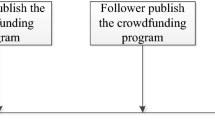Abstract
While our society began to recognize the importance to capture the uncertain preference of people, the existing literature has confined its research work only under a static preference framework in crowdfunding. This paper represents the attempt to incorporate people uncertain preference on product quality and attributes into crowdfunding for production and pricing. More specifically, with describe the uncertain preference of supporters on product quality with robust optimization method, the distribution of the uncertain preference in the worst cases is solved firstly and the corresponding optimal product quality is investigated. Then, according to the different preference of supporters for product attributes, the differentiated pricing strategy is considered in the second stage. Finally, the model is extended to the situation that the third-party platform is participation to illustrate the effectiveness of platform on sharing economy. The research provides the sponsor with the quality level of product production and the corresponding optimal prices for different product quality and attributes. And the results show that: (i) It is optimal for sponsor to increase the unit price of the taste product and not to decide the product quality at the early stage when the risk of investors uncertain preference on product quality is greater than a certain value; (ii) Compare with the low effort level of the platform, the price of the taste product is lower when the platform effort level is high.



Similar content being viewed by others
References
Bi, G.B., Geng, B.T., Liu, L.D.: On the fixed and flexible funding mechanisms in reward-based crowdfunding. Eur. J. Oper. Res. 279(1), 168–183 (2019)
Herv, F., Manth, E., Sannajust, A., Schwienbacher, A.: Determinants of individual investment decisions in investment-based crowdfunding. J. Bus. Finan. Acc. 5(6), 762–783 (2019)
Irwin, D., Scott, J.M.: Barriers faced by SMEs in raising bank finance. Int. J. Entrepreneurial Behav. Res. 16(3), 245–259 (2010)
Ferdinand, T., Alexander, H., Carolin, B., Alexander, B., Sascha, K.: Following the crowd—does crowdfunding affect venture capitalists selection of entrepreneurial ventures? J. Small Bus. Manage. 57(4), 1378–1398 (2019)
Hildebrand, T., Manju, P.A., Rocholld, C.: Adverse incentives in crowdfunding. Manage. Sci. 63(3), 587–608 (2017)
Bi, S., Liu, Z., Usman, K.: The influence of online information on investing decisions of rewardbased crowdfunding. J. Bus. Res. 71, 10–18 (2017)
Ben-Tal, A., Nemirovski, A.: Robust optimization. Math. Oper. Res. 23(4), 769–805 (1998)
Ben-Tal, A., Nemirovski, A.: Robust solutions of uncertain liner programs. Oper. Res. Lett. 25(1), 1–13 (1999)
Kleeman, K., Voss, G.G., Riede, r K.: Under paid innovators: the commercial utilization of consumer work through crowdsourcing. Sci. Technol. Innov. Stud. 4(1), 5–26 (2011)
Israa, A.M.A., Hebatallah, G.: The effect of microfinance on income inequality: perspective of developing countries. J. Econ. Manage. 35(1), 40–62 (2019)
Kim, H.J., Lee, J., Chae, D.K., Kim, S.W.: Crowdsourced promotions in doubt: analyzing effective crowdsourced promotions. Inf. Sci. 432, 185–198 (2018)
Tomczak, A., Brem, A.: A conceptualized investment model of crowdfunding. Venture Cap. 15(4), 335–359 (2013)
Moonhee, C., Gawon, K.: A cross-cultural comparative analysis of crowdfunding projects in the United States and South Korea. Comput. Hum. Behav. 72, 312–320 (2017)
Lukkarinen, A., Teich, J.E., Wallenius, H., Wallenius, J.: Success drivers of online equity crowdfunding campaigns. Decis. Support Syst. 87, 26–38 (2016)
Allison, T.H., Davis, B.C., Short, J.C., Webb, J.M.: Crowdfunding in a prosocial microlending environment: examining the role of intrinsic versus extrinsic cues. Entrepreneurship Theory Pract. 39(1), 53–73 (2015)
Belleflamme, P., Lambert, T., Schwienbacher, A.: Crowdfunding: tapping the right crowd. J. Bus. Ventur. 29(5), 585–609 (2014)
Frydrych, D., Bock, A.J., Kinder, T., Benjamin, K.: Exploring entrepreneurial legitimacy in reward-based crowdfunding. Venture Cap. 16(3), 247–269 (2014)
Hyeog-In, K., Lee, S., Na, Y.: Success and failure case analysis of crowdfunding: focused on community art project. J. Korea Contents Assoc. 14(7), 125–136 (2014)
Beier, M., Wagner, K.: Crowdfunding success of tourism projects-evidence from Switzerland. In: ENTER eTourism Conference 2015, At Lugano, Volume: 22.
Bernstein, S., Korteweg, A., Laws, K.: Attracting early-stage investors: evidence from a randomized field experiment. J. Finance 72(2), 509–538 (2017)
Wessel, M., Thies, F., Benlia, A.: Opening the floodgates: the implications of increasing platform openness in crowdfunding. J. Inf. Technol. 32, 344–360 (2017)
Hu, M., Li, X., Shi, M.: Product and pricing decisions in crowdfunding. Mark. Sci. 34(3), 331–345 (2015)
Chen, Y., Zhang, R., Liu, B.: Joint decisions on production and pricing with strategic consumers for green crowdfunding products. Int. J. Environ. Res. Public Health 14(9), 1–18 (2017)
Fishburn, P.: Nonlinear Preferences and Utility Theory. The John Hopkins University Press, Baltimore (1988)
VonNeumann, J., Morgenstern, O.: The Theory of Gamesand Economic Behaviour, 2nd edn. Princeton University Press, Princeton (1947)
Savage, L.: The Foundations of Statistics. Wiley, New York (1954)
Chris, S.: Developments in non-expected utility theory: the hunt for a descriptive theory of choice under risk. J. Econ. Lit. 38(2), 332–382 (2000)
Liu, W.M., Deng, T.H., Li, J.B.: Product packing and stacking under uncertainty: a robust approach. Eur. J. Oper. Res. 277, 903–917 (2019)
Chang, C.M., Chang, W.J.: Robust fuzzy control with transient and steady—state performance constraints for ship fin stabilizing systems. Int. J. Fuzzy Syst. 21(2), 518–531 (2019)
Chen, C.C.: Annealing robust fuzzy neural networks for modeling of molecular autoregulatory feedback loop systems. Int. J. Fuzzy Syst. 10(1), 11–17 (2008)
Awasthi, P., Goyal, V., Lu, B.Y.: On the adaptivity gap in two-stage robust linear optimization under uncertain packing constraints. Math. Progr. 173(1–2), 313–352 (2018)
Keeney, R.L.: Multiplicative utility functions. Oper. Res. 22(1), 22–34 (1974)
Zhang, Z.M., Xu, X.O.: Principal agent model based design and outsourcing of information value. Clust Comput 20(1), 60–79 (2017)
Scarf, H.: A Min–Max Solution of an Inventory Problem, pp. 201–209. Standford University Press, California (1958)
Constantin, P.N., Persson, L.E.: Duality and convex optimization. Convex Functions and Their Applications, pp. 255–300 (2018)
Author information
Authors and Affiliations
Corresponding author
Appendix
Appendix
1.1 A. Proof of Theorem 1
From Eq. (4), the excepted profit of the sponsor is given as follows:
For Fig. 1a, the intersection point is \(\varepsilon _1=0\) and the cut-off point is \(\varepsilon _2=u+\frac{\sigma ^2}{u-\varepsilon _1}\), and \(\varepsilon _2>Q\), so \(Q<\frac{u^2+\sigma ^2}{2u}\). Therefore, the followings equations can be written according the tangent properties as:
By solving the Eq. (A.2), the following equations can gotten as
and
Taking the Eq. (A.3) into Eq. (A.1), the excepted profit of the sponsor is written as
Therefore, the Eq. (10) is proved.
The detail proof of Theorem 1 is given as following. According to Eq. (18), the expected profit function under the worst distribution is obtained as shown in the following:
(1) When \(Q<\frac{u^2+\sigma ^2}{2u}\)
From Eq. (A.5), when \(\frac{u}{\sigma }=\sqrt{\frac{k-v}{m-k}},(m>k>v)\), \( \frac{\partial \underline{\Pi _s^2}(Q,p_2)}{\partial Q}=0\). The profit function \( \underline{\Pi _s^2}(Q,p_2)\) is a monotonically increasing function of Q when \(\frac{u}{\sigma }<\sqrt{\frac{k-v}{m-k}}\), and \( \underline{\Pi _s^2}(Q,p_2)\) is a monotonically decreasing function of Q when \(\frac{u}{\sigma }\ge \sqrt{\frac{k-v}{m-k}}\). Therefore, the optimal product production quality level can be expressed by the following formula
(2) When \(Q\ge \frac{u^2+\sigma ^2}{2u}\)
Since the second derivative of the expected profit function is less than zero, so \(\underline{\Pi _s}(Q,p_2)\) is a concave function, and when \( \frac{\partial \underline{\Pi _s^1}(Q,p_2)}{\partial Q}=0\), we can get \(Q_2^*=u+\frac{\sigma }{2}(\sqrt{\frac{m-k}{k-v}}-\sqrt{\frac{k-v}{m-k}})\). Combining the condition \(Q\ge \frac{u^2+\sigma ^2}{2u}\), we can get
When \(Q=\frac{u^2+\sigma ^2}{2u}\), the piecewise function is continuous, that is \(\underline{\Pi _s^1}(Q,p_2)=\underline{\Pi _s^2}(Q,p_2)\). Therefore, combining Eqs. (A.6) and (A.10), the optimal product quality level can be written as
1.2 B. Proof of Theorem 2
(i) When \(\frac{u}{\sigma }>e \sqrt{\frac{k-v}{m-k}}\), it is always hold \(a>(1-\lambda )\phi e \sigma \sqrt{\frac{k-v}{m-k}}\), \(\overline{p_2}=\frac{a}{b}-\frac{(1-\lambda )\phi e\sigma }{b}\sqrt{\frac{k-v}{m-k}}>0\), the pricing problem in the following two situations is discussed.
(1) When \(p_2\le \overline{p_2}\), the expected profit function is \(\underline{\Pi _s^1}\):
From the Eq. (18), we can know the expected profit function is a concave function of \(p_2\), and when \(\frac{\partial \underline{\Pi _s^1}}{\partial p_2}=0\)
When \(p_{21}<p_{21}^*\), the expected profit function \(\underline{\Pi _s^1}\) is a monotonically increase function of \(p_2\), and the expected profit function \(\underline{\Pi _s^1}\) is a monotonically decreasing function of \(p_2\) when \(p_{21}\ge p_{21}^*\). Therefore, when \(\sigma <\sigma _1=\left(\frac{a}{2(1-\lambda ) \phi e}+\frac{[p_1\lambda (\theta +\alpha d-k)]b}{2[(1-\lambda )(\phi e)]^2}\right)\sqrt{\frac{m-k}{k-v}}\), we get \(p_{21}^*< \overline{p_2}\), and the optimal price is \(\overline{p_2}\). When \(\sigma \ge \sigma _1=\left(\frac{a}{2(1-\lambda ) \phi e}+\frac{[p_1\lambda (\theta +\alpha d-k)]b}{2(1-\lambda )^3(\phi e)62}\right)\sqrt{\frac{m-k}{k-v}}\), we get \(p_{21}^*\ge \overline{p_2}\), and the optimal price is \(p_{21}^*\). So the optimal product price can be written as follows
(2) When \(p_2 > \overline{p_2}\), the expected profit function is \(\underline{\Pi _s^2}\):
The expected profit function \(\underline{\Pi _s^2}\) is a concave function of \(p_2\), and when \(\frac{\partial \underline{\Pi _s^1}}{\partial p_2}=0\)
When \(p_{22}<p_{22}^*\), the expected profit function \(\underline{\Pi _s^2}\) is a monotonically increase function of \(p_2\), and the expected profit function \(\underline{\Pi _s^2}\) is a monotonically decreasing function of \(p_2\) when \(p_{22}\ge p_{22}^*\). Therefore, when \(\sigma <\sigma _2= \left(\frac{a}{2(1-\lambda ) \phi e}+\frac{[p_1\lambda (\theta +\alpha d-m)]b}{2[(1-\lambda )(\phi e)]^2}\right)\sqrt{\frac{m-k}{k-v}}\), we get \(p_{22}^*< \overline{p_2}\) and the optimal price is \(p_{22}^*\). When \(\sigma \ge \sigma _2= \left(\frac{a}{2(1-\lambda ) \phi e}+\frac{[p_1\lambda (\theta +\alpha d-m)]b}{2[(1-\lambda )(\phi e)]^2}\right)\sqrt{\frac{m-k}{k-v}}\), we get \(p_{22}^*\ge \overline{p_2}\)
and the optimal product price is \(\overline{p_2}\). So the optimal price can be written as follows
Combing Eqs. (B.4) and (B.8), the intersection of two profit functions \(\underline{\Pi _s^1}\) and \(\underline{\Pi _s^2}\) has three different cases due to the difference values of \(\sigma \). In the following Fig. 4, the graphic of the intersection is given to illustrate the optimal product price.
In Fig. 4a, \(\sigma >\sigma _1\), and the maximum value of the \(\underline{\Pi _s^1}\) is get at \(p=p_{21}^*\) and the maximum value of the \(\underline{\Pi _s^2}\) is get at \(p=\overline{p_2}\). The two profit functions are continuous at \(p=\overline{p_2}\) and \(\underline{\Pi _s^1}(p_{21}^*)>\underline{\Pi _s^2}(\overline{p_2})\), therefore the optimal price is \(p=p_{21}^*\). In Fig. 4b, \(\sigma \le \sigma _2\), and the maximum value of the \(\underline{\Pi _s^1}\) is get at \(p=\overline{p_2}\) and the maximum value of the \(\underline{\Pi _s^2}\) is get at \(p=p_{22}^*\). The two profit functions are continuous at \(p=\overline{p_2}\) and \(\underline{\Pi _s^2}(p_{22}^*)>\underline{\Pi _s^1}(\overline{p_2})\), therefore the optimal price is \(p=p_{22}^*\). In the situation of Fig. 2c, we need to compare the values of \(\underline{\Pi _s^1}(p_{21}^*)\), \(\underline{\Pi _s^2}(p_{22}^*)\). When \(\underline{\Pi _s^1}(p_{21}^*)= \underline{\Pi _s^2}(p_{22}^*)\), we get the followings
Therefore we can get
When \(\sigma \le \sigma _3\), we get \(\underline{\Pi _s^1}(p_{21}^*)-\underline{\Pi _s^2}(p_{22}^*)>0\), the optimal price is \(p_{21}^*\). And when \(\sigma >\sigma _3\), \(\underline{\Pi _s^1}(p_{21}^*)-\underline{\Pi _s^2}(p_{22}^*)<0\), the optimal price is \(p_{22}^*\). By comparing the values of \(\sigma _1\), \(\sigma _2\) and \(\sigma _3\), we can find that \(\sigma _1>\sigma _3>\sigma _2\). Therefore the optimal price is given as
Combining Eqs. (B.4), (B.8) and (B.11), we analysis the price in the following two as
-
(1)
When \(\sigma <\sigma _3\), the optimal price of the product is \(p_{21}^*\). If \( \frac{u}{\sigma }\ge \sqrt{\frac{k-v}{m-k}}\), we get \( \sigma \le \sigma _1\), \(Q^*=\frac{a-bp_2}{(1-\lambda )\phi e}+\frac{\sigma }{2} \left(\sqrt{\frac{m-k}{k-v}}-\sqrt{\frac{k-v}{m-k}}\right)\). If \( \sigma >\sigma _1\), \(Q^*=0\), this result does not match the condition \(\sigma <\sigma _3\). Therefore, the optimal price and initial quality level of the product is \(p=p_{21}^*\), \(Q^*=\frac{a-bp_2}{(1-\lambda )\phi e}+\frac{\sigma }{2}(\sqrt{\frac{m-k}{k-v}}-\sqrt{\frac{k-v}{m-k}})\).
-
(2)
When \(\sigma \ge \sigma _3\), the optimal price of the product is \(p_{21}^*\). If \( \frac{u}{\sigma }\ge \sqrt{\frac{k-v}{m-k}}\), we get \(\sigma \le \sigma _2\), which is not match the condition \(\sigma \ge \sigma _3(\sigma _3>\sigma _2)\). Therefore, when \( \frac{u}{\sigma }< \sqrt{\frac{k-v}{m-k}}\), we get the optimal price and initial quality of the product is \(p=p_{22}^*\),\(Q^*=0\).
Combining the above analysis, the price and initial quality of the product is given as follows
From the Eq. (B.12), when the supporter product quality preference uncertainty risk is greater than \(\sigma _3\), the company will chooses to increase the product price and not determine the production quality of the product in advance to avoid the risk.
(ii) When \(\frac{u}{\sigma }<e \sqrt{\frac{k-v}{m-k}}\), it hold \(\overline{p_2}=\frac{a}{b}-\frac{(1-\lambda )\phi e\sigma }{b}\sqrt{\frac{k-v}{m-k}}\le 0\), the sponsor will not provide the product with taste attributes, the product quality level is \(Q^*\) in Theorem 1 and the price is \(p_1\).
Rights and permissions
About this article
Cite this article
Wei, J. Joint Production and Pricing Strategy in Robust Model of Crowdfunding Considering Uncertain Preference. Int. J. Fuzzy Syst. 22, 1342–1355 (2020). https://doi.org/10.1007/s40815-020-00838-5
Received:
Revised:
Accepted:
Published:
Issue Date:
DOI: https://doi.org/10.1007/s40815-020-00838-5





